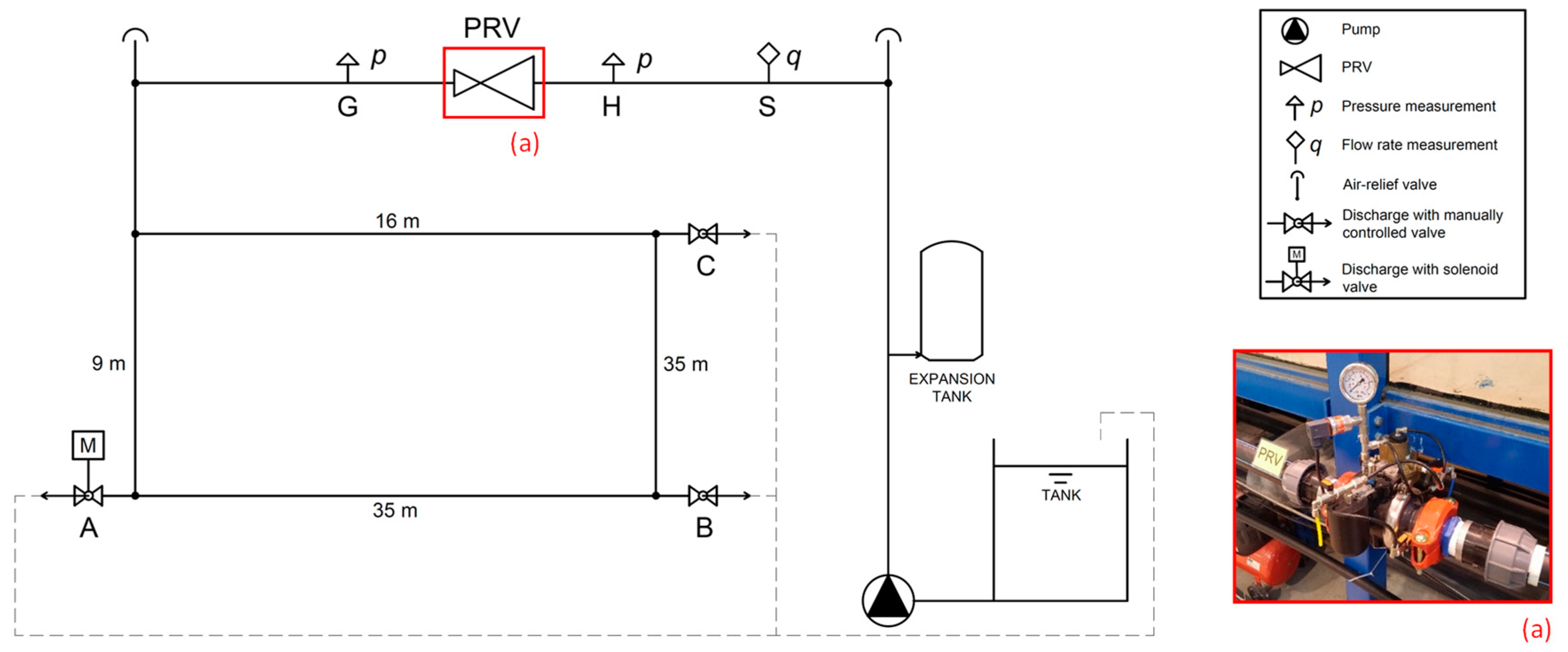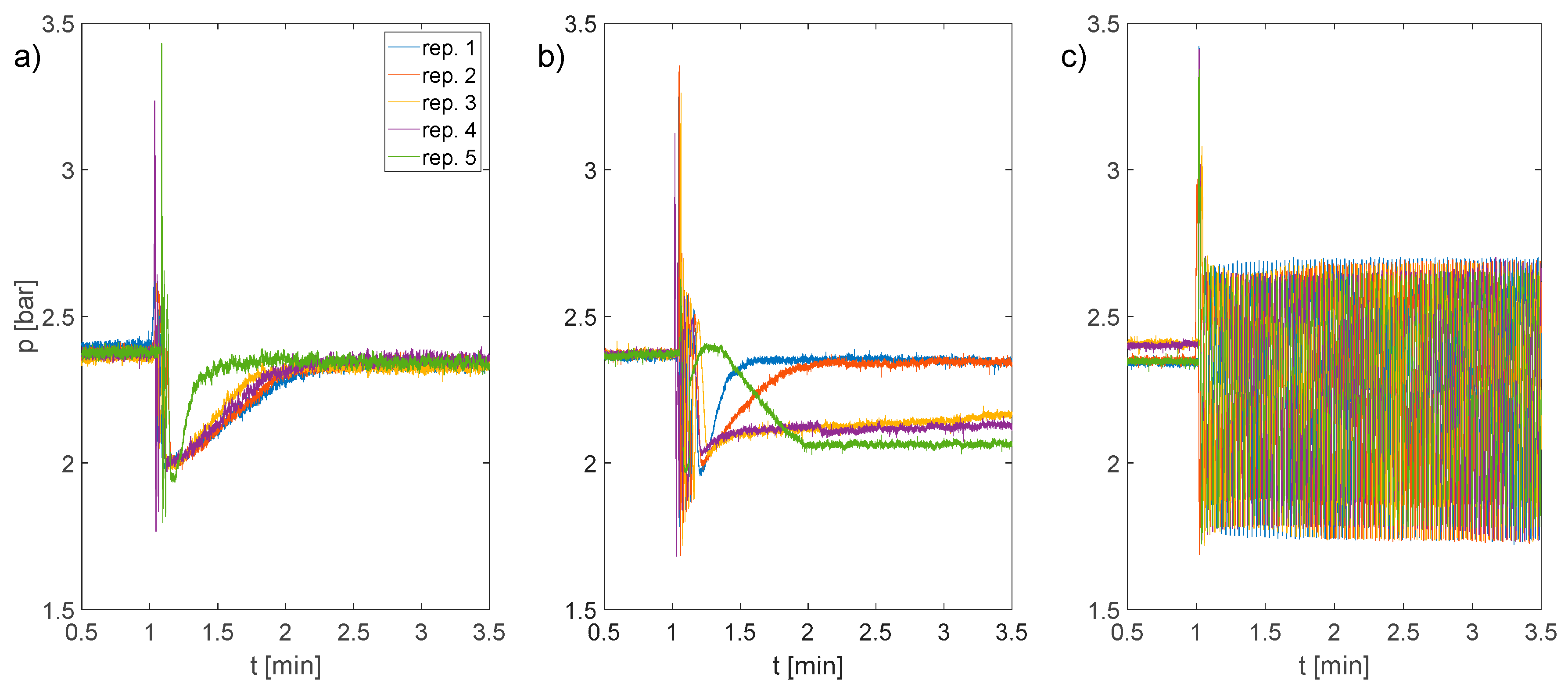Laboratory Analysis of a Piston-Actuated Pressure Reducing Valve under Low Flow Conditions †
Abstract
:1. Introduction
2. Materials and Methods
3. Results
4. Conclusions
Conflicts of Interest
References
- Janus, T.; Ulanicki, B. Hydraulic Modelling for Pressure Reducing Valve Controller Design Addressing Disturbance Rejection and Stability Properties. Procedia Eng. 2017, 186, 635–642. Available online: https://www.sciencedirect.com/science/article/pii/S1877705817314339 (accessed on 10 October 2019). [CrossRef]
- Giugni, M.; Fontana, N.; Ranucci, A. Optimal Location of PRVs and Turbines in Water Distribution Systems. J. Water Res. Plan. Manag. 2014, 140. Available online: https://ascelibrary.org/doi/abs/10.1061/%28ASCE%29WR.1943-5452.0000418 (accessed on 10 October 2019). [CrossRef]
- Fontana, N.; Giugni, M.; Glielmo, L.; Marini, G.; Verrilli, F. Real-Time Control of a PRV in Water Distribution Networks for Pressure Regulation: Theoretical Framework and Laboratory Experiments. J. Water Res. Plan. Manag. 2018, 144. Available online: https://ascelibrary.org/doi/10.1061/%28ASCE%29WR.1943-5452.0000855 (accessed on 10 October 2019). [CrossRef]
- Meniconi, S.; Brunone, B.; Mazzetti, E.; Laucelli, D.B.; Borta, G. Hydraulic characterization and transient response of pressure reducing valves: Laboratory experiments. J. Hydroinform. 2017, 19, 798–810. Available online: https://iwaponline.com/jh/article/19/6/798/37859/Hydraulic-characterization-and-transient-response (accessed on 10 October 2019). [CrossRef]
- Ulanicki, B.; Skworcow, P. Why PRVs Tends to Oscillate at Low Flows. Procedia Eng. 2014, 89, 378–385. Available online: https://www.sciencedirect.com/science/article/pii/S1877705814023170 (accessed on 10 October 2019). [CrossRef]
- Changklom, J.; Stoianov, I. Fault Detection and Diagnosis for Pressure Control Valves in Water Supply Networks. In Proceedings of the CCWI 2017, Sheffield, UK, 5–7 September 2017. [Google Scholar]
- Saisanketvalves. Available online: https://www.saisanketvalves.com (accessed on 10 October 2019).
- Dempster, W.; Alshaikh, M. An Investigation of the Two Phase Flow and Force Characteristics of a Safety Valve. Procedia Eng. 2015, 130, 77–86. Available online: https://www.sciencedirect.com/science/article/pii/S1877705815040618 (accessed on 10 October 2019). [CrossRef]


© 2019 by the authors. Licensee MDPI, Basel, Switzerland. This article is an open access article distributed under the terms and conditions of the Creative Commons Attribution (CC BY) license (https://creativecommons.org/licenses/by/4.0/).
Share and Cite
Zarbo, R.; Marsili, V.; Alvisi, S.; Franchini, M. Laboratory Analysis of a Piston-Actuated Pressure Reducing Valve under Low Flow Conditions. Proceedings 2020, 48, 26. https://doi.org/10.3390/ECWS-4-06444
Zarbo R, Marsili V, Alvisi S, Franchini M. Laboratory Analysis of a Piston-Actuated Pressure Reducing Valve under Low Flow Conditions. Proceedings. 2020; 48(1):26. https://doi.org/10.3390/ECWS-4-06444
Chicago/Turabian StyleZarbo, Riccardo, Valentina Marsili, Stefano Alvisi, and Marco Franchini. 2020. "Laboratory Analysis of a Piston-Actuated Pressure Reducing Valve under Low Flow Conditions" Proceedings 48, no. 1: 26. https://doi.org/10.3390/ECWS-4-06444
APA StyleZarbo, R., Marsili, V., Alvisi, S., & Franchini, M. (2020). Laboratory Analysis of a Piston-Actuated Pressure Reducing Valve under Low Flow Conditions. Proceedings, 48(1), 26. https://doi.org/10.3390/ECWS-4-06444







